This reform is not just a personnel adjustment; it resembles a strategic game surrounding the future direction of Ethereum.
Written by: Sam @IOSG
In March 2025, the Ethereum Foundation (EF) announced a significant leadership change: Executive Director Aya Miyaguchi stepped down from her role as Executive Director to become the Foundation's Chair; at the same time, Hsiao-Wei Wang and Tomasz Stańczak were appointed as the new Co-Executive Directors; former EF researcher Danny Ryan joined Etherealize.
Facing fierce competition, Ethereum is at a transformative moment. This change is not merely a personnel adjustment but rather a strategic game regarding Ethereum's future direction. For a long time, Aya has driven Ethereum to build an "infinite garden" with an idealistic vision. However, as market competition intensified and issues such as high gas fees and network congestion emerged, the community raised many questions about her conservative resource allocation and cultural promotion strategies. There were even extreme criticisms and attacks directed at Aya, prompting Vitalik Buterin to call for calm.
Against this backdrop, the EF is attempting to respond to external dissatisfaction through leadership adjustments while striving to find a new balance between idealism and market realities. This article will explore the strategic transformation's achievements so far from three dimensions: changes in EF's organizational structure, the positioning of Etherealize, and EF's recent adjustments and future outlook.
Dual Leadership: A New Power and Responsibility Structure
Aya's Tenure
Since 2018, Aya Miyaguchi has served as the Executive Director of EF. Aya's leadership coincided with Ethereum's significant transition from proof-of-work to proof-of-stake.
At the strategic level, Aya advocated and implemented guiding principles known as the "subtraction philosophy." This principle requires the Foundation to consciously avoid becoming a highly centralized power entity, distributing more opportunities and responsibilities throughout the community. At the same time, EF adheres to the core values of openness, trusted neutrality, and decentralization, avoiding profit chasing or adopting aggressive marketing strategies.
In terms of internal structural adjustments, Aya led the establishment of several new teams and projects. For example, the EF Fellowship program launched in 2022 supports builders in emerging communities, contributing to the vision of "the next billion." Additionally, new conference formats such as Devconnect, introduced in 2021, demonstrate EF's new attempts in conference organization and community building.
EF Structure and Recent Changes
As a non-profit organization, the Ethereum Foundation does not have a pyramid-like hierarchical structure but has evolved into a "team community." The Foundation supports numerous semi-autonomous teams that operate independently in their respective areas of expertise while collaborating organically under shared values.
EF's organizational structure can be divided into four main functional areas: Protocol Research and Development (PR&D), Ecosystem Development (EcoDev), Operational Support (Ops), and Privacy and Scalability Exploration (PSE). Each area has its own responsibilities while coordinating with external communities, research institutions, and development teams through the "Protocol Guild" and "Protocol Support" teams.
The Foundation plays a bridging role in coordinating cross-team collaboration, such as organizing client interoperability workshops, promoting network upgrades, and hosting global events like Devcon. Meanwhile, EF's management has consistently avoided micromanaging every project, instead encouraging teams to work in an atmosphere of "self-driven responsibility."
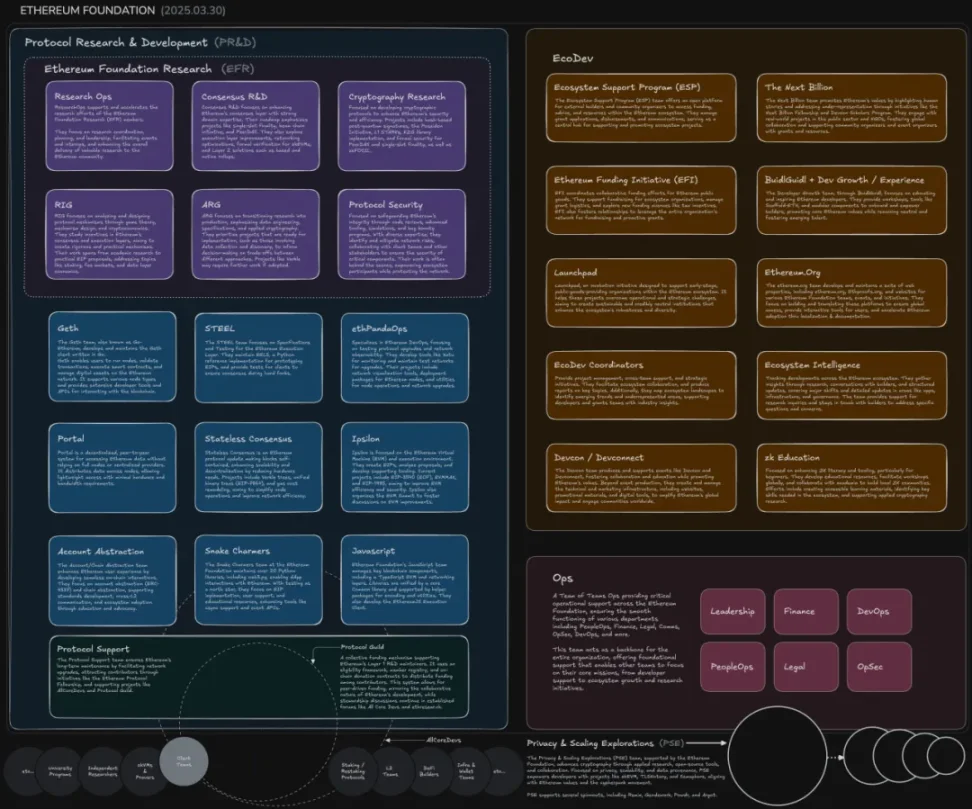
The research team responsible for core protocol development also underwent significant changes from late 2024 to early 2025. The Ethereum Foundation Research Department (EFR) was restructured from a single research team into five specialized groups: Application Research Group (ARG), Consensus R&D, Cryptography, Protocol Security, and Robust Incentives Group (RIG). This split was driven by the Foundation's rapid expansion in cryptography and security, necessitating more specialized teams to focus on different research directions and improve R&D efficiency and transparency. At the same time, long-term researchers Alex Stokes and Barnabé Monnot were appointed as co-leads of research direction.
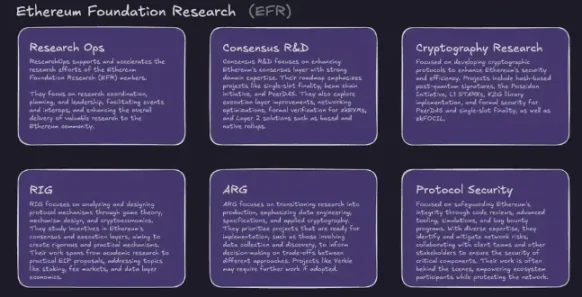
The PSE team, a key group focused on zero-knowledge proofs and privacy technology research, originated from the AppliedZKP team within EF and has now become an independent "team community" operating in parallel with other semi-autonomous teams in the Foundation. Through various formats such as workshops, summer camps, and experimental networks (like Alphanet and Testnet), PSE supports the Ethereum network's evolution towards a balance of "privacy and scalability." The establishment of PSE stems from the Ethereum Foundation's urgent need for practical applications of privacy and scalability technologies. Previously, research on zero-knowledge and MPC often remained at the academic level; PSE emerged to drive technological maturity in an "application-driven" manner, bridging the gap between research and engineering. In 2024, the team underwent a significant reorganization, with many original members leaving later that year, effectively achieving a "restart."
Following the latest personnel changes, EF's management structure is as follows: Aya transitioned to Chair, responsible for promoting strategic cooperation and maintaining relationships, while reducing direct involvement in specific affairs; in management, Hsiao-Wei Wang and Tomasz serve as Co-Executive Directors, collaboratively handling management tasks; in the research field, Barnabé Monnot and Alex Stokes will jointly serve as co-leads of research, while Tju Liang Chua continues as EF's General Counsel, and Bastian and Josh Stark continue to take on EF's management and operational responsibilities.
The current main leadership of EF is as follows:
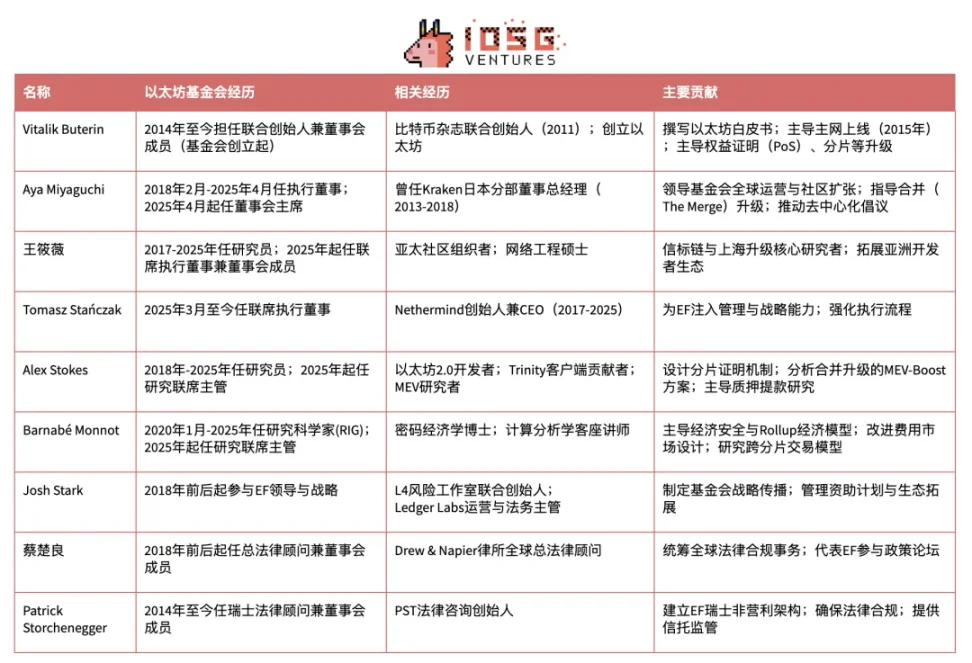
Hsiao-Wei Wang and Tomasz: A Dual Engine of Technology and Management
In this reform, EF introduced a dual leadership structure, appointing two executive directors with strong technical backgrounds and rich practical experience:
Hsiao-Wei Wang
Since joining EF in 2017, Hsiao-Wei Wang has served as a core researcher. She graduated from National Chiao Tung University in Taiwan with a major in Network Engineering, possessing a solid technical foundation. She has deeply engaged in sharding and beacon chain-related technologies and played a key role in The Merge in 2022. Now, as Executive Director, Hsiao-Wei is not only responsible for leading R&D direction but also bears the important task of promoting community building. Her appointment is seen as a crucial turning point for Ethereum to regain its spirit of technological innovation and grassroots involvement.
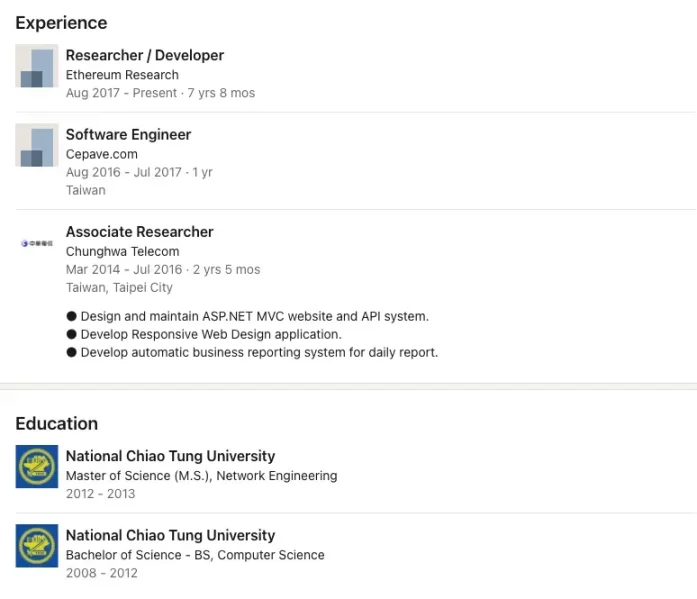
Tomasz Stańczak
Tomasz is well-known for his leadership at Nethermind. After more than seven years of effort, Nethermind currently holds about 35% market share in the Execution client market, second only to Geth. Meanwhile, Nethermind continues to expand its business scope, launching various products and actively engaging in collaborations and research to contribute to the Ethereum ecosystem. Tomasz not only led Nethermind to achieve remarkable results in client development but also actively explored cutting-edge topics such as MEV and PBS. The rich experience Tomasz accumulated at Nethermind injects management experience and strategic vision into EF.
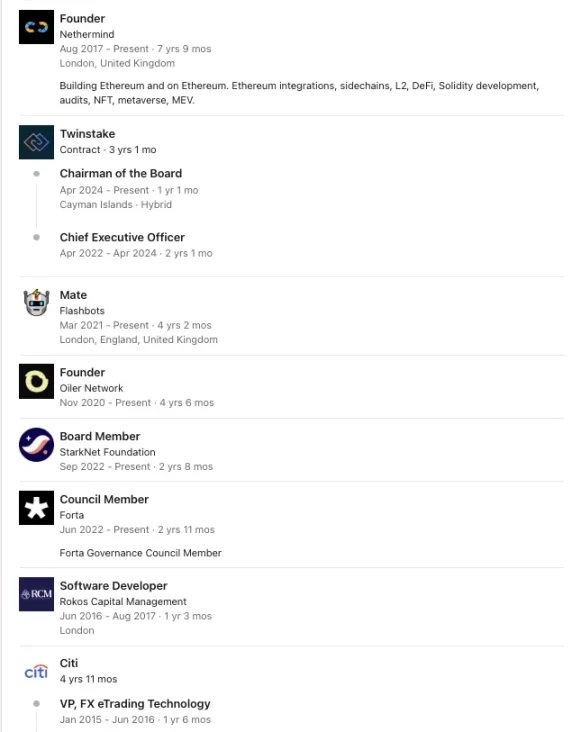
The new structure aims to achieve the following goals:
Decentralize decision-making responsibilities: Each executive director has independent decision-making authority, reducing the risk of single points of failure and allowing stakeholders to choose their points of contact based on their preferences. For example, institutions or developers in Europe can meet and communicate directly with Tomasz based on his visit schedule from April to July. This also allows stakeholders to flexibly engage with different regional affairs and control the pace of collaboration.
Complement technical and management advantages: Hsiao-Wei's in-depth research on Ethereum's core innovations (such as the beacon chain, sharding technology, and ETH 2.0) complements Tomasz's mature experience in organizational expansion and operational management.
Aya Transitioning to Chair, Vitalik Returning to Research
Meanwhile, former Executive Director Aya Miyaguchi has transitioned to Chair, focusing more on external strategic cooperation and relationship maintenance. After serving as Executive Director for seven years, Aya is now concentrating on strategic guidance and external communication, while daily operational management is fully handled by Hsiao-Wei and Tomasz Stańczak.
According to Tomasz, one of the goals following this leadership change is to allow Vitalik to invest more in research and exploration rather than daily coordination or crisis response. Vitalik's recent articles on RISC-V and zkVMs have opened promising research directions, and his discussions on privacy have helped the community realign with EF's core values. At the same time, while Vitalik's proposals carry significant weight, they are more intended to spark discussion and advance challenging research areas; community reviews may significantly alter or even reject these proposals.
Community Response
After the new appointments were announced, the Ethereum community congratulated and welcomed Hsiao-Wei and Tomasz.
Paradigm's Chief Technology Officer Georgios Konstantopoulos stated that Tomasz has reached a "new height": he is wise and experienced, adept at grasping the nuances of technology, and possesses the ability to build and lead efficient large teams. The community generally believes that Hsiao-Wei's deep understanding of the protocol will ensure that the Foundation's technical direction remains in the hands of professionals. Sassal highly praised the appointment of the Co-Executive Directors and viewed this leadership adjustment as a "significant transformation" to propel Ethereum into its next phase. Many builders are optimistically anticipating that a leader from the research field paired with a leader from the engineering and client team will help achieve a good balance at the governance level.
Some community members expressed surprise that Danny Ryan did not take on a major leadership role at EF. However, on the same weekend that EF announced the new Co-Executive Directors, Danny Ryan also announced his return to the Ethereum ecosystem as a co-founder of Etherealize. Even voices that had previously been critical, such as Evan Van Ness, later acknowledged Vitalik's decision; he noted that while he had hoped to see Danny play a larger role in EF, the new Co-Executive Directors, with their solid qualifications and experience, have quelled the previous leadership controversies.
Overall, while discussions within the community surrounding Aya Miyaguchi's departure were intense during the transition period, they ultimately converged into a constructive consensus. Community members recognized Aya's contributions to EF, and many key figures publicly expressed their gratitude to her; at the same time, there are high hopes for the new appointments of Hsiao-Wei Wang and Tomasz Stańczak, with expectations that the new leadership structure will address past shortcomings in communication and technical collaboration.
Ecological Reconstruction: The Rise of Etherealize
Previously, the community widely anticipated that Danny Ryan would directly take over the position of Executive Director at EF. However, unexpectedly, Danny Ryan did not return to EF but instead re-entered the Ethereum ecosystem as a co-founder of Etherealize. This choice also hints at another possibility: the formation of a new organization similar to EF, aimed at addressing EF's shortcomings and focusing on the real implementation of Ethereum's technology and business potential.
As Danny Ryan stated, "Instead of talking about the vision of Ethereum, it's better to show how institutions can practically utilize Ethereum." Guided by this philosophy, he chose Etherealize—a platform focused on the commercial expansion and marketing of the Ethereum ecosystem.
Core Mission
Etherealize is not just a marketing tool but a multidimensional platform, with its core mission reflected in the following four aspects:
Institutional Access and Productization: Just like BlackRock's $1 billion on-chain U.S. Treasury and Franklin Templeton's mutual funds, Etherealize provides traditional financial institutions with "full support from concept design to on-chain deployment," significantly reducing the trial-and-error costs for institutions.
Integration of Technology and Market: Bridging R&D and business development, rapidly iterating zero-knowledge proofs, privacy modules, and cross-Rollup bridging solutions, and validating and optimizing them in real customer environments.
Policy Advocacy and Regulatory Dialogue: Deeply participating in policy roundtables and Senate blockchain hearings, publishing a series of reports titled "Plain Language Regulatory Policy Interpretations," analyzing topics such as stablecoin legislation, tokenized securities rules, and market structure reforms. The recently promoted "Regulatory Sandbox Certification Program" has attracted participation from Switzerland's FINMA and Singapore's MAS for co-construction.
Feedback and Transparency: The Etherealize data dashboard tracks on-chain core metrics (total locked value on L2, tokenized asset scale, settlement delays) and off-chain institutional dynamics (compliance certification progress, partner growth) in real-time. The monthly "Institutional Insights" report directly translates customer operational pain points into protocol layer optimization needs.
Dual-Track Structure
Etherealize has officially split into a dual legal entity structure to simultaneously advance market delivery and ecological governance.
The for-profit entity Etherealize Inc. (a C corporation registered in Delaware) focuses on "providing end-to-end tokenization services, Layer 2 deployment solutions, and compliance toolchains for banks and asset management institutions," with its core mission being to lower the on-chain entry barriers for traditional financial institutions through standardized infrastructure.
The non-profit entity Etherealize Foundation focuses on "open R&D, privacy tool development, and policy advocacy to bridge the real world and Ethereum," emphasizing the maintenance of Ethereum's trusted neutrality and regulatory adaptability.

This dual-track model has propelled Etherealize to achieve leapfrog development within the first three months of operation: the for-profit sector successfully launched BlackRock and Franklin Templeton's on-chain mutual fund projects; the non-profit sector simultaneously conducted regulatory roundtable meetings and piloted privacy protection solutions based on zero-knowledge proofs. The synergistic effect of "commercial closed-loop + ecological foundation" is accelerating the institutionalization process of Ethereum.
Origins of Etherealize
The concept of Etherealize originated on July 23, 2024, during the launch of the Ethereum ETF, when Grant Hummer observed that although the ETF's launch marked Wall Street's recognition of Ethereum, the actual adoption was far below expectations. This gap prompted him to collaborate with investor James Fickle to find a leader with both Wall Street experience and Ethereum knowledge, ultimately identifying Vivek Raman.
After receiving funding from Vitalik Buterin and the Ethereum Foundation, the team was officially established in January 2025 and quickly expanded from pure business development to delivery implementation. Subsequently, Etherealize realized that leveraging Wall Street required not only the dissemination of ideas but also the provision of seamless access to tangible tools. To this end, Vivek Raman brought in his close friend Zach Obront as a co-founder to reconstruct the technical foundation. Finally, Danny Ryan joined as Chief Strategy Officer, becoming the last co-founder.
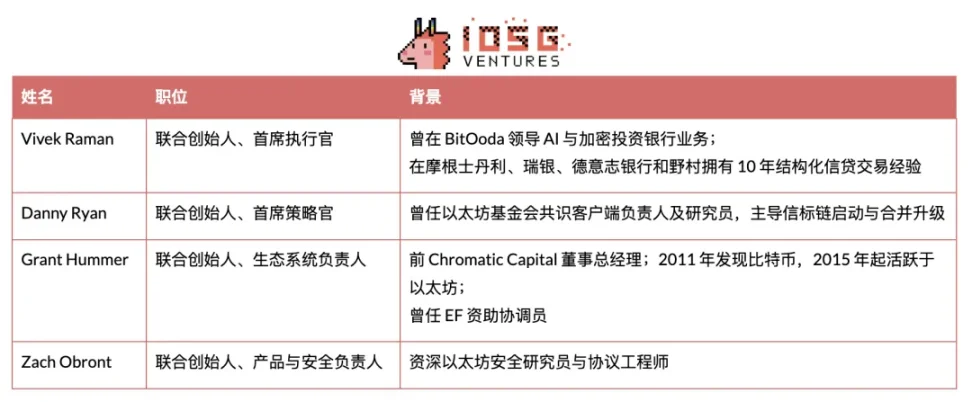
2025 Strategic Blueprint
In an interview with Bankless and DeFi Dad, Danny Ryan shared Etherealize's recent plans, with the following core roadmap for 2025:
Q2: Launch institutional-grade SDK, integrating custody interfaces, compliance reviews, and gas fee optimization modules.
Q3: Initiate a pilot for enterprise wallets based on the Noir zero-knowledge compiler.
Q4: Enter the Asia-Pacific and European markets, customizing regulatory adaptation solutions through partnerships with Singapore's Digital Port and Switzerland's Crypto Valley.
When asked about the project roadmap and future challenges, Danny and Vivek elaborated on their strategies:

Ethereum vs. Solana: Underlying Currents in Institutional Competition
The traditional financial sector has long focused on Ethereum and its Layer 2 ecosystem, which has launched its technical applications earlier and achieved higher market acceptance compared to Solana. According to data from RWA.xyz, Ethereum and its Layer 2 ecosystem account for over 50% of the value in RWA.
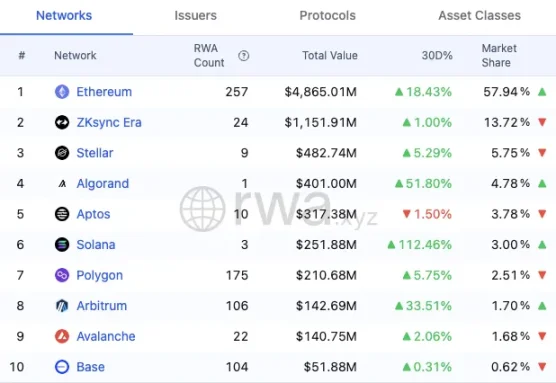
In collaborations with traditional financial institutions, Ethereum's earlier launch has established numerous cooperative cases within its ecosystem:
Fidelity: Fidelity established Fidelity Digital Assets in 2018, beginning to lay out digital assets and provide Bitcoin custody services. In 2019, Tom Jessop, head of its cryptocurrency division, expressed strong interest in Ethereum, noting that the company had invested significant resources in the Ethereum space. In 2024, it launched the Ethereum spot ETF (FETH).
JPMorgan: JPMorgan launched the open-source enterprise ledger Quorum based on Ethereum technology in 2016, supporting cross-bank information networks and projects like JPM Coin. In November 2022, in collaboration with the Singapore central bank on Project Guardian, it completed the first DeFi cross-currency transaction using the Polygon network.
Goldman Sachs: In 2021, Goldman Sachs served as a joint bookrunner for the issuance of €100 million digital bonds by the European Investment Bank (EIB), utilizing Ethereum smart contracts to tokenize securities and cash.
HSBC: HSBC, through its HSBC Orion platform, utilizes distributed ledger technology to support bond issuance, digital gold, and custody services, while achieving interoperability between private chains and public chains like Ethereum.
UBS: In November 2024, UBS Asset Management launched the first tokenized investment fund issued on the Ethereum network—the "UBS USD Money Market Fund Token" (uMINT), converting money market fund shares into on-chain tokens. In early 2025, UBS showcased experimental results based on Ethereum Layer 2 zkSync, utilizing zero-knowledge proof technology to enable split transactions for certain gold investment products and migrating retail gold products to the zkSync "Validium" network.
In contrast, Solana has fewer collaborations with traditional financial institutions. Additionally, RWA on Solana is primarily concentrated in stablecoins, with its non-stablecoin asset ratio being lower than that of Ethereum. Currently, mainstream government bonds and other fund projects are as shown, with relatively few related projects in terms of quantity and amount; at the same time, the types of projects are relatively singular, not yet covering large-scale commodity RWA projects, as well as private credit and private equity fields.
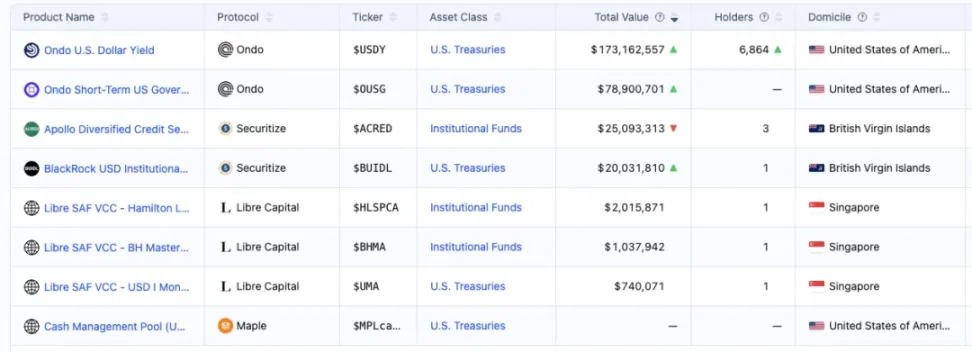
Currently, the Ethereum platform still leads in the value of RWA assets, with its Layer 2 ecosystem also carrying a large amount of RWA assets, far surpassing other public chain projects. Although six Ethereum ETFs have been approved in the market, Solana-related ETFs have yet to receive approval. However, this year mainstream institutions such as BlackRock's BUIDL and Franklin Templeton's BENJI have successively launched on Solana, intensifying competition. EF has also established a clear strategic layout to respond to challenges, and the establishment of Etherealize further highlights Ethereum's proactive attitude in seeking institutional collaboration.
Summary
As _gabrielShapir0 pointed out in a comment: "Etherealize can essentially be seen as a second EF, representing a cultural and strategic diversion that makes Ethereum more socialized and diversified."
In fact, Etherealize marks a key political moment in Ethereum's history—during which cultural differences began to emerge. Therefore, Ethereum's L0 future will place greater emphasis on socialized decentralization, as reflected in "client diversity." This has led to the emergence of various competitive top-level strategic visions in the market, focusing on how to promote ETH and future development directions, each with its own emphasis.
Etherealize adopts a dual-layer structure, encompassing both for-profit entities and non-profit organizations, providing greater flexibility for its operations. The two parts perform their respective roles and collaborate closely. Another significant advantage is its technology-driven focus on the product itself, rather than solely relying on business development. It is these characteristics that make Etherealize an efficient platform focused on connecting with traditional financial institutions.
Recent Adjustments and Outlook of EF
Despite facing numerous challenges, Ethereum still possesses deep advantages that support its position in the crypto space—advantages that are often downplayed by its leadership, leading to negative criticisms overshadowing its core narrative. Systematically sorting through these advantages helps establish an objective framework for understanding Ethereum's potential.
EF Silviculture Society: Diverse Consultation and Internal Innovation
EF has launched the Silviculture Society—an informal think tank composed of external experts aimed at providing cross-disciplinary advice and multi-faceted insights to the Foundation. The think tank members come from various fields including technology, law, academia, and industry, participating on a voluntary basis for a year, submitting confidential opinions to the EF Board through specialized channels, and exploring a flexible and diverse internal feedback mechanism.
Concerns
It may merely be a superficial cultural experiment, unlikely to enhance decision-making efficiency.
The short-term voluntary participation model may struggle to attract experts with long-term deep insights, affecting the continuity and professionalism of the advice.
It remains unclear how external advice will truly translate into internal decisions, and the transparency and effectiveness of the feedback mechanism need to be tested.
Financial Strategy and Budget Management
In financial management, EF has introduced a budget strategy of "spending 15% of remaining funds annually" to ensure the long-term sustainable operation of funds. According to publicly available data, EF's treasury fiat assets decreased from $1.294 billion in March 2022 to $784 million in October 2024, while its holdings in ETH only declined by about 11%. Meanwhile, EF's annual expenditures rose from $48 million in 2021 to $135 million in 2023, indicating increasing investments in ecological support, R&D, and personnel salaries.
Concerns
EF holds a large amount of ETH; if ETH prices continue to languish, although the decline in ETH holdings is limited, the significant shrinkage of dollar-denominated assets may indicate potential financial health risks.
While the "15% remaining funds" strategy is attractive, it lacks clear execution details, and the strategy has not been effectively implemented in recent years, leading to continuous increases in annual expenditures.
The sharp increase in annual spending may reflect inefficient resource allocation or indicate rising costs in R&D and funding.
Specific expenditure details and funding usage plans have not been fully disclosed, making it difficult to conduct a comprehensive assessment of operational conditions.
Despite substantial investments, the actual results have not met expectations, indicating a disconnect between internal management and market demands.
Venturing into DeFi and Ecological Innovation
EF announced an investment of 50,000 ETH to participate in DeFi projects and entered the DeFi ecosystem through a newly established multi-signature wallet. At the same time, tools like EtherStrategy for full-chain asset management and discussions on the new governance model "Second Foundation" have emerged, showing that EF is exploring diversified innovative models to drive the continuous evolution of the ecosystem.
Questions and Doubts
Venturing into DeFi while staking ETH may force EF to take a stance on sensitive issues like hard forks in the future, potentially affecting its positioning as a global neutral platform.
The market questions whether this venture aligns with the positioning of a non-profit organization and whether it may lead to a deviation in resource and strategic focus, thereby affecting overall ecological stability.
Social Media and Market Promotion
In response to past criticisms of insufficient presence on social media, EF has significantly increased its investment across major platforms. Since January of this year, EF has reactivated multiple official accounts, promptly conveying internal reforms and strategic initiatives through a wealth of original content and dynamic reposts. Meanwhile, core figures like Vitalik Buterin have enhanced the Ethereum brand image by changing their profile pictures and engaging frequently, reinforcing the "Ethereum First" concept in dialogues with traditional finance and policymakers.
Concerns
The active presence on social media may only be superficial public relations, failing to address internal governance and actual results issues.
The actual effectiveness of market promotion and the depth of engagement with traditional financial institutions and real applications remain uncertain.
EF Funding
In 2025, EF launched two rounds of timed, thematic special funding—the Pectra Forward-looking Special and the 2025 Academic Funding, both of which have now closed; meanwhile, the ESP's small grants (≤ $30,000, decision within about two weeks) and project grants (no funding limit, in-depth collaborative review) continue to be open year-round.
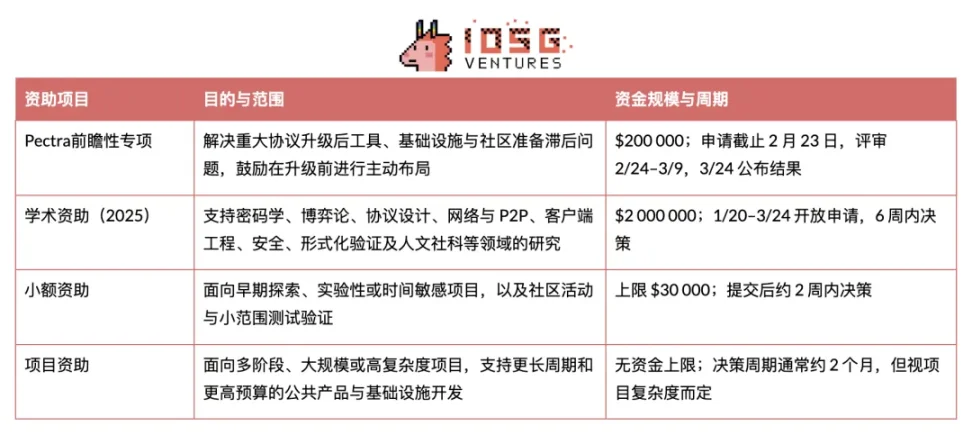
EF Strategic Outlook
After the management adjustments settled, Vitalik was able to refocus on research; EF also synchronized with the community on the main directions for the next phase: first, the overall roadmap forwarded and supplemented by Tomasz, and second, the privacy roadmap proposed by Vitalik.
Regarding the overall roadmap, the simplified roadmap focuses on three core areas:
Enhancing data processing capabilities through Blob-based scaling;
Improving L1 throughput through targeted protocol upgrades;
Enhancing user experience by deepening L2 interoperability and focusing on the application layer.
At the same time, Tomasz emphasized that, in addition to these, secondary matters include:
Always minting assets on L1
Winning the real-world asset (RWA) and stablecoin markets
Improving communication and clarifying community and user expectations
Significantly enhancing security standards under a trillion-dollar economy
Promoting goal-driven R&D within the Foundation
Meanwhile, in his latest article "A maximally simple L1 privacy roadmap" (https://ethereum-magicians.org/t/a-maximally-simple-l1-privacy-roadmap/23459), Vitalik proposed his vision for Ethereum's privacy roadmap, covering four key forms of privacy: on-chain payment privacy, partial anonymization of in-app activities, hidden chain data reading, and network layer anonymization.
The roadmap mainly includes:
Natively integrating privacy tools like Railgun and Privacy Pools into mainstream wallets, with "shielded balance" and "send from shielded balance" enabled by default;
Promoting a "one address per application" design, with privacy-protecting "spontaneous transactions" enabled by default;
Implementing FOCIL and EIP-7701 to simplify zero-replay, relay-free anti-censorship transactions;
Introducing TEE-based RPC privacy solutions in wallets in the short term, gradually transitioning to more cryptographically secure PIR in the future;
Allowing wallets to connect to multiple RPC nodes (optional mixed network access) and advancing light client support to reduce metadata leakage;
Developing zero-knowledge proof aggregation protocols to compress the gas costs of privacy transactions;
Creating privacy-aware keystore wallets that allow users to seamlessly upgrade signature algorithms or verification logic between L1/L2 while maintaining privacy.
Conclusion
The Ethereum ecosystem is undergoing a paradigm shift from within. The introduction of a dual leadership structure has achieved a decentralization of decision-making responsibilities and a complementarity of technical and management advantages, while also allowing Vitalik to step back from operational practices and focus on cutting-edge research and leading Ethereum. A series of changes within EF, including the split of the research department, the appointment of new research co-chairs, the implementation of a pragmatism and efficiency-first approach, and active participation in DeFi and social media operations, represent positive changes that demonstrate a determination to seek transformation and breakthroughs in a fiercely competitive market.
The emergence of Etherealize is an important milestone in strategic transformation. In connecting with traditional financial institutions, EF often has not been the best choice due to its organizational structure, positioning, and history, and has failed to meet the urgent demands of the market. Etherealize, tailored for institutional clients, effectively compensates for EF's shortcomings with its clear Wall Street service positioning and flexible organizational structure, assisting EF's work without adding to its burden.
Thus, EF and Etherealize have brought organizational innovation and rejuvenation to Ethereum, enabling it to better respond to a more competitive environment. The next challenge lies in the core issues regarding Ethereum's future: the positioning and narrative of ETH as an asset, the integration of the Ethereum ecosystem, and the enhancement of performance and user experience. These fundamental strategic dilemmas cannot be addressed merely through organizational adjustments or tactical improvements and will serve as a key test for the new generation of leadership.
Despite the ongoing challenges and doubts, these changes undoubtedly pave a path for Ethereum to explore new possibilities, marking the beginning of a truly forward-looking new era.
免责声明:本文章仅代表作者个人观点,不代表本平台的立场和观点。本文章仅供信息分享,不构成对任何人的任何投资建议。用户与作者之间的任何争议,与本平台无关。如网页中刊载的文章或图片涉及侵权,请提供相关的权利证明和身份证明发送邮件到support@aicoin.com,本平台相关工作人员将会进行核查。




